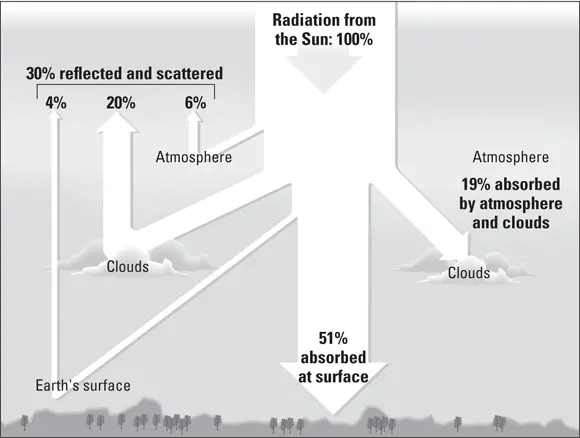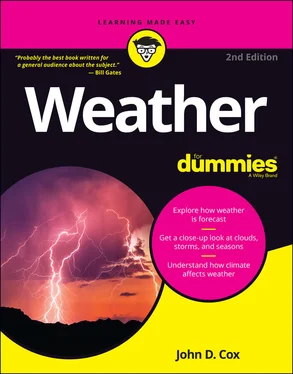While weather watchers like you and I focus on the sky, on the rays of the Sun beating down on us and on the rain or snow falling from the clouds, a weather scientist sees things as part of an energy transfer that is moving from the ground up. A winter storm at the seam between two air masses, which this chapter’s previous section, “ News from the Fronts,” is about and Chapter 8describes more fully, is transferring energy from the surface to the atmosphere. So is a summer thunderstorm, which Chapter 10describes. And so is an autumn hurricane, which Chapter 7details. Through conduction and convection, they are all moving one form of heat or another from a warmer region to a cooler one.
Later in this chapter, the section, “ The Big Picture” explains why the atmosphere never succeeds at this process of balancing the Sun’s energy around the world. Figure 3-4 shows what happens to the radiation from the Sun striking Earth.

FIGURE 3-4:Here’s what happens to the radiation from the Sun once it reaches the atmosphere.
Some sunshine is missing. Nobody leave the room.
About half of the solar energy that reaches Earth’s atmosphere ends up getting absorbed at the surface. There it gets converted into invisible long-wave radiation. When it re-enters the atmosphere sooner or later, it helps make weather. Another 20 percent gets absorbed by the atmosphere and clouds on the way down.
So what happens to the other 30 percent of the sunshine? People who have been put on the case say it gets lost to scattering, when sunlight rays collide with air molecules or tiny dust particles are reflected back off of bright surfaces. The brighter the surface, the more light it reflects (and the less it absorbs). This is why a white shirt is cooler than a dark one on a summer day. The percentage of light that a surface reflects back, rather than absorbs, is a property that scientists call albedo .
Albedo is a big deal. For example, 20 percent of the incoming sunshine bounces right off the bright white cloud tops and heads back toward space. About 4 percent is reflected back from Earth, but there are big differences in the albedo of different surfaces. It ranges anywhere from 95 percent for fresh snow to 2 percent for calm water.
Looking absolutely radiant!
Don’t look now, but waves of energy are radiating all around you. The fact is, everything that has a temperature above absolute zero (–459.67 degrees Fahrenheit/–273 degrees Celsius) is giving off at least some waves of radiation. Your body, for example. Even your Weather For Dummies book. This radiation is an important part of the process of turning the Sun’s energy into weather.
When it comes down from the Sun, however, most of the energy arrives as powerful short-wave radiation, including the spectrum of light that you can see, and this passes right through the atmosphere and strikes the surface of the Earth. Depending on the kind of surface it hits, it bounces back or is absorbed. It all depends on color and surface texture and other properties of the surface. Notice how hot a black asphalt parking lot gets on a summer afternoon, absorbing the heat, and yet, how quickly it cools, or radiates it away, overnight.
People who plan cities and buildings are studying these different heat-absorbing and radiating properties of materials to make downtowns and neighborhoods more energy-efficient and comfortable places to be.
In case you haven’t noticed, the energy that radiates back from the surface travels as long infrared waves, which you and I can’t see. Invisible it might be, but this form of radiation is more important than you might think. The atmosphere, which lets most of the incoming short-wave sunlight pass right through without absorbing it, catches a lot of the rebounding long-wave heat energy and keeps it around. This produces the so-called greenhouse effect that is discussed in detail in Chapter 14.
Clouds love this long-wave infrared radiation. The tiny water particles in them soak it right up.
Have you ever noticed that a cloudy night often is warmer than a clear one? Those clouds are absorbing that radiation coming off the Earth and radiating a lot of it back toward the ground, acting like a big infrared blanket over you.
A cloudy day can be a different story, depending on the season. In spring and summer, the same clouds that kept you warm at night now are preventing the sunlight from reaching you. More often than not, a calm cloudy summer day is cooler than a calm sunny day. In winter, clouds during the day often make temperatures near the ground warmer than on a clear day.
Did you know there are two forms of heat?
One is the kind of heat that you feel on your arm, say, when you exercise or hang out in the sunshine. This they call sensible heat, because you can sense it. (This sounds pretty sensible to me, although I wouldn’t spend too much time out in that sunshine.)
The other kind is latent heat. This is heat that is released or absorbed when things like water change phase, or form, between vapor and liquid and ice. They call it latent because it is stored away, or hidden. (They could have called it insensible, you know, but nobody asked me.)
This idea sounds a little tricky at first, but really it’s no sweat. Look at it this way:
When you perspire, your body is working on getting rid of excess sensible heat. The sweat on your arm evaporates, converts from liquid water to gaseous vapor. This process of conversion from liquid to gas state absorbs heat, and the coolness you feel is the sensible heat being converted to latent heat. The heat that left your body is stored away in the molecules of that little bubble of air that just lifted off from your arm.
Now follow that water vapor off of your arm as it rises up higher and higher into the sky and forms a cloud. When it does this, it converts itself back into liquid, tiny water droplets, and gives the heat it took off your body back to the atmosphere. Oops, things look a little unstable up there. A storm is brewing! Now see what you’ve done!
This invisible long-wave radiation that is given off by the Sun-warmed Earth is more important to weather than direct sunlight. Somebody who has spent the day in the sunshine may find it hard to believe, but a weather scientist will tell you: The energy radiating back up into the atmosphere from the surface of the Earth as long-wave radiation has more direct effect on weather processes than the short-wave energy that comes directly through the atmosphere as sunshine.
Heat that is moving from the surface of water or land warms the air just above it in a process of direct transfer known as conduction . This is the way the icy cold of a glass or the boiling heat from a cup travels up the handle of a metal spoon, for example. And just around the metal spoon handle, a thin layer of air is absorbing some of the heat.
 From this thin layer of air at the surface, the heat energy finds its way into higher levels of the atmosphere through a process known as convection, the vertical mixing of liquid or gas of different temperatures. Convection is what happens when a pot of water boils.
From this thin layer of air at the surface, the heat energy finds its way into higher levels of the atmosphere through a process known as convection, the vertical mixing of liquid or gas of different temperatures. Convection is what happens when a pot of water boils.
 Some of this air mixing happens through the mechanical forcing of wind. This is referred to as forced convection. Blowing near the surface, swirling eddies in the flowing air carry the heat up into the sky. Two general rules apply: the faster the wind, the greater this kind of convection. Also, the more uneven the surface — the bigger and more numerous the eddies — the greater this kind of mixing.
Some of this air mixing happens through the mechanical forcing of wind. This is referred to as forced convection. Blowing near the surface, swirling eddies in the flowing air carry the heat up into the sky. Two general rules apply: the faster the wind, the greater this kind of convection. Also, the more uneven the surface — the bigger and more numerous the eddies — the greater this kind of mixing.
Читать дальше


 From this thin layer of air at the surface, the heat energy finds its way into higher levels of the atmosphere through a process known as convection, the vertical mixing of liquid or gas of different temperatures. Convection is what happens when a pot of water boils.
From this thin layer of air at the surface, the heat energy finds its way into higher levels of the atmosphere through a process known as convection, the vertical mixing of liquid or gas of different temperatures. Convection is what happens when a pot of water boils. Some of this air mixing happens through the mechanical forcing of wind. This is referred to as forced convection. Blowing near the surface, swirling eddies in the flowing air carry the heat up into the sky. Two general rules apply: the faster the wind, the greater this kind of convection. Also, the more uneven the surface — the bigger and more numerous the eddies — the greater this kind of mixing.
Some of this air mixing happens through the mechanical forcing of wind. This is referred to as forced convection. Blowing near the surface, swirling eddies in the flowing air carry the heat up into the sky. Two general rules apply: the faster the wind, the greater this kind of convection. Also, the more uneven the surface — the bigger and more numerous the eddies — the greater this kind of mixing.










